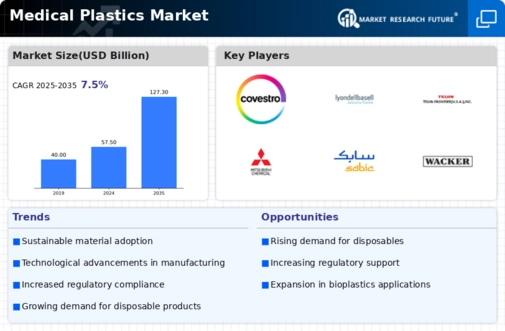Top Industry Leaders in the Medical Plastics Market

Strategies for Market Dominance:
-
Innovation: Companies like Covestro and Evonik are pioneering bio-based and biodegradable plastics, addressing environmental concerns and capturing new market segments. 3D printing technologies are also gaining traction, with companies like Medtronic and Stryker investing heavily in this space. -
Acquisitions and Partnerships: Mergers and acquisitions are a common strategy for expanding market share and acquiring new technologies. Recent examples include BASF acquiring Solvay's engineering plastics business and Dow Chemical acquiring DuPont's Performance Materials division. Partnerships with medical device manufacturers and research institutions are also crucial for developing and commercializing new products. -
Regional Focus: Emerging economies like China and India are experiencing rapid growth in healthcare spending, making them attractive targets for expansion. Companies like Röchling and HMC Polymers are establishing strong production and distribution networks in these regions. -
Cost-Effectiveness and Efficiency: Streamlining production processes, optimizing supply chains, and offering competitive pricing are vital for maintaining profitability in a cost-sensitive market. Companies like Eastman Chemical and Trinseo Corp. are focusing on these aspects to stay ahead of the curve.
Factors Influencing Market Share:
-
Product Portfolio: A diverse and innovative product portfolio catering to various medical applications is crucial for attracting and retaining customers. Companies offering a wide range of plastics, from biocompatibles to high-performance polymers, are well-positioned to gain market share. -
Regulatory Compliance: Stringent regulations regarding biocompatibility, safety, and sustainability are essential considerations for medical plastics manufacturers. Companies with a strong track record of compliance and proactive investment in research and development enjoy a competitive advantage. -
Intellectual Property: Protecting proprietary technologies and formulations through patents and trademarks is critical for maintaining a competitive edge. Companies like Saint-Gobain and Sabic are actively investing in R&D to create differentiated products and secure intellectual property rights. -
Customer Relationships: Building strong relationships with medical device manufacturers, hospitals, and other healthcare providers is essential for understanding market needs and tailoring product offerings accordingly. Companies with a customer-centric approach and reliable supply chains are more likely to win over clients.
Key Companies in the Medical Plastics market include
- Exxon Mobil Corporation (US)
- BASF SE (Germany)
- DuPont de Nemours, Inc. (US)
- Evonik Industries AG (Germany)
- Celanese Corporation (US)
- Covestro AG (Germany)
- Solvay (Belgium)
- The Lubrizol Corporation (US)
- Röchling Group (Germany)
- Tekni-Plex (US)
- Eastman Chemical Company (US)
- Saint-Gobain Performance Plastics (France)
- Trinseo (US)
- Ensinger (Germany)
- Fortune Medical Plastic Products Company (China)
Recent Developments:
September 2023: Evonik partners with a leading medical device manufacturer to develop a biodegradable suture material made from plant-based resources.
November 2023: A consortium of industry leaders, including BASF and Saint-Gobain, announces a new initiative to develop a global recycling standard for medical plastics.
December 2023: The European Union proposes stricter regulations on the use of single-use medical plastics, potentially impacting the market for disposable medical devices.

